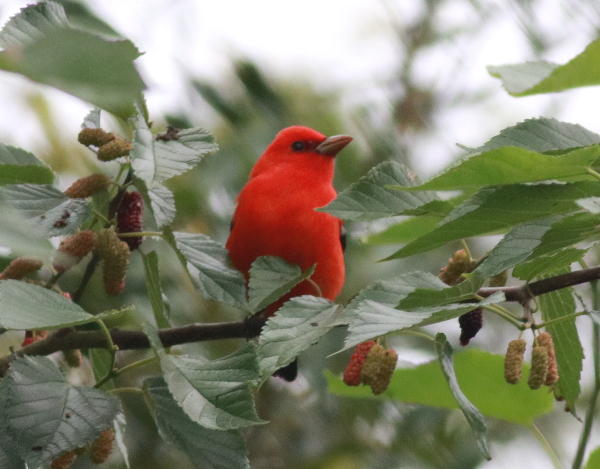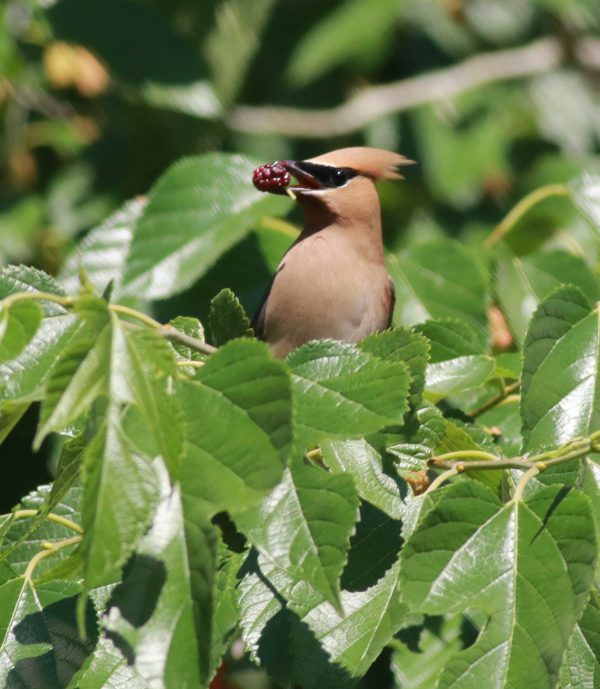
A bird magnet can be a fruiting tree, flowering shrub, or a vibrant flower garden. This Scarlet Tanager surrounded by mulberry fruits was feasting during a migration stopover.

Who knows what birds will arrive at a magnet for birds. This fruiting tree attracted many Cedar Waxwings, Gray Catbirds, Scarlet and Summer Tanagers, a few warblers and an Indigo Bunting, with the birds observed day to day varying.
|
Enjoy your yard this spring while doing what you can to make it more bird friendly each season. Whether you have a well-established landscape, or if you are looking for a change in your yard, many people make one or two additions each year that add to the overall appearance of their yard, and that likewise attracts and benefits birds. If you are considering a spring addition to your yard, make it a “bird magnet” – a tree or a couple bushes that will attract birds during one of two seasons of the year when it flowers or fruits.
A single tree can make all the difference in your yard; one that flowers in the spring that attracts orioles, hummingbirds, grosbeaks, warblers, and vireos looking for flower nectar and the small insects they need during a migration stopover. The same tree may also produce fruit in the fall that benefits robins and other thrushes, waxwings, tanagers, and catbirds. This flowering and fruiting cycle may also be true for select bushes, and a garden area with nectar-producing flowers, or sunflowers and other seed-bearing plants can be a magnet too.
Landscaping with native plants is also always a plus for attracting native birds.
Here is a great example of a “bird magnet” that is paying off in a big way:
A gentleman from the Houston area recently shared the “fruits” of planting a mulberry tree in the back corner of his yard 15 years ago. During a recent afternoon he positioned a lawn chair in the shade to relax nearby and observe the birds that visited the fruiting tree from 3 to 6pm. He reported that the local Carolina Chickadees, Downy and Red-bellied Woodpeckers, Northern Mockingbirds, and Northern Cardinals were feasting, but it was really the migrants who were amazing, including at least 20 male Scarlet Tanagers, maybe a half-dozen male Summer Tanagers, several Baltimore Orioles and an Orchard Oriole, many Indigo Buntings, at least 20 Swainson’s Thrushes, a few Gray-cheeked Thrushes, about half a dozen Gray Catbirds, 2 or 3 Magnolia Warblers, 3 Black-throated Green Warblers, 6 Tennessee Warblers, 1 Yellow-breasted Chat, a Warbling Vireo, and a Philadelphia Vireo!
Talk about a bird magnet, after reading an exciting report like that, any birder that lives within the growing range of mulberry trees should be inspired to plant one in their yard – immediately. But that’s just one example of how your choice of a new tree, shrubs, and perennials can attract birds to your view while benefitting local and migrating birds that need food and a place to rest and shelter – and possibly a place to nest.
Of course, the varieties of trees, shrubs, and flowering plants that you can grow will depend on the climatic zone where you live. One way to select a magnet tree is to think about which tree(s) in your neighborhood or the surrounding area produce flowers and/or fruits that attract birds – and are pleasing to your eye. This may turn out to be a little research project for you to keep aware of and react to when you witness birds utilizing a certain tree. Local nurseries can be helpful, and local birding stores like a Wild Birds Unlimited or Wild Bird Centers store might be an even better bet to ask for advice. If there’s not one of these stores or an independent birding store in your area, call the WBU store closest to your home – even if it’s in a nearby state – and ask for their advice.
Another source of information is the National Wildlife Federation and their Garden for Wildlife project, which offers lists of plants that benefit birds in specific regions of the country (see https://www.gardenforwildlife.org/ And you can try contacting birding friends, birding clubs, Audubon centers, and other nature centers to get their input.
As you add plants to your yard, make each choice count – like the mulberry tree – and appreciate how it will benefit birds for years to come, while beautifying your yard and accenting your home. Enjoy the birds of spring migration!
Share your backyard birding experiences and photos at editorstbw2@gmail.com